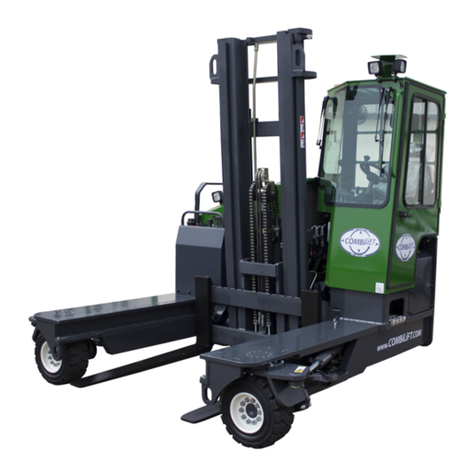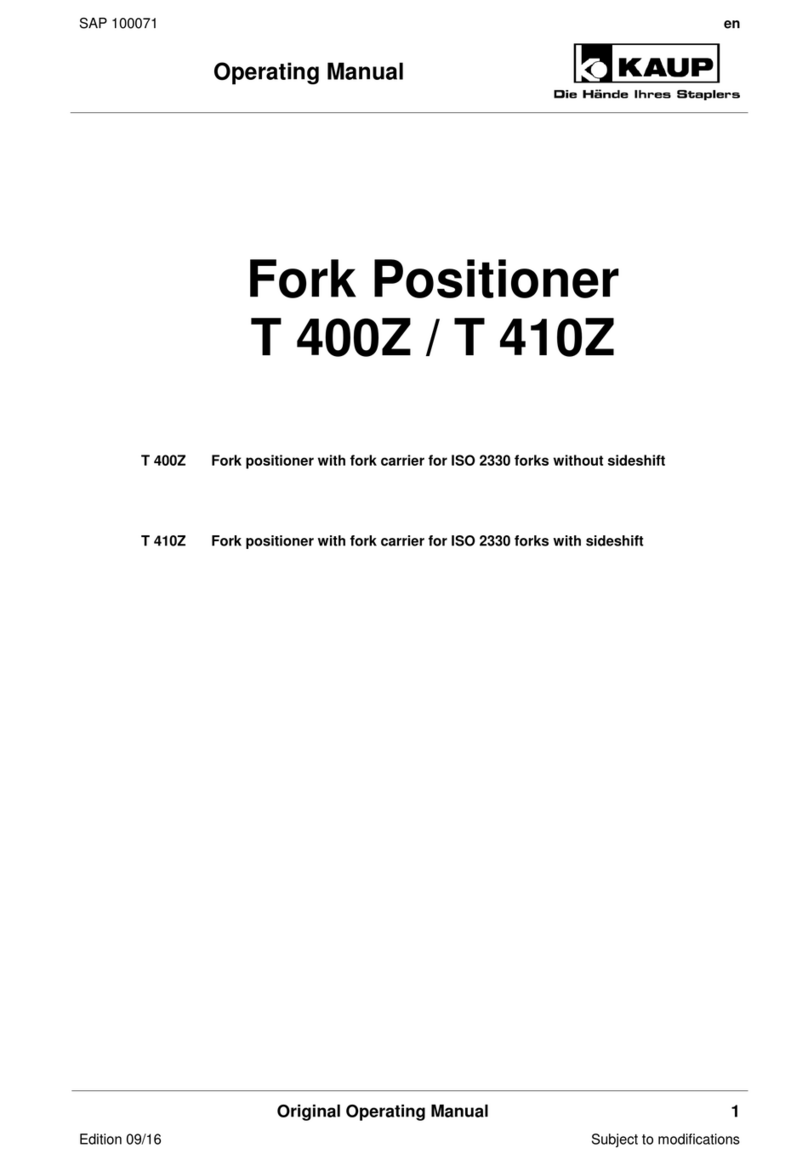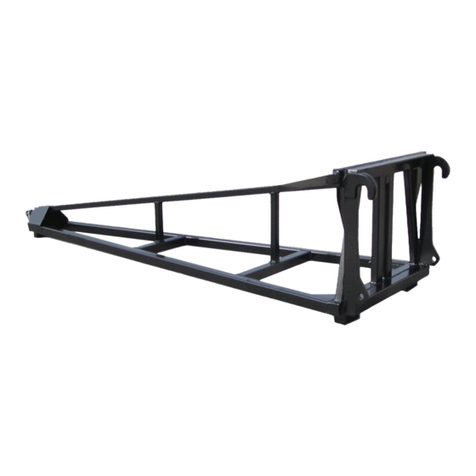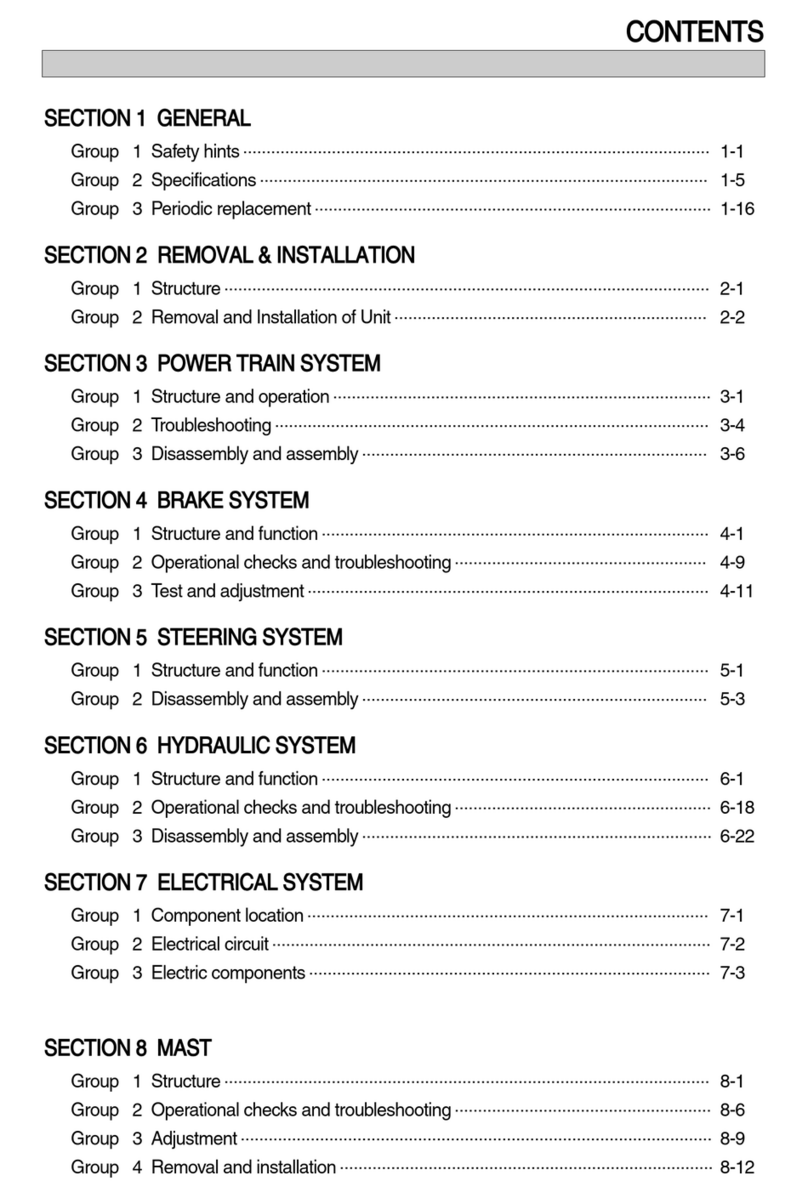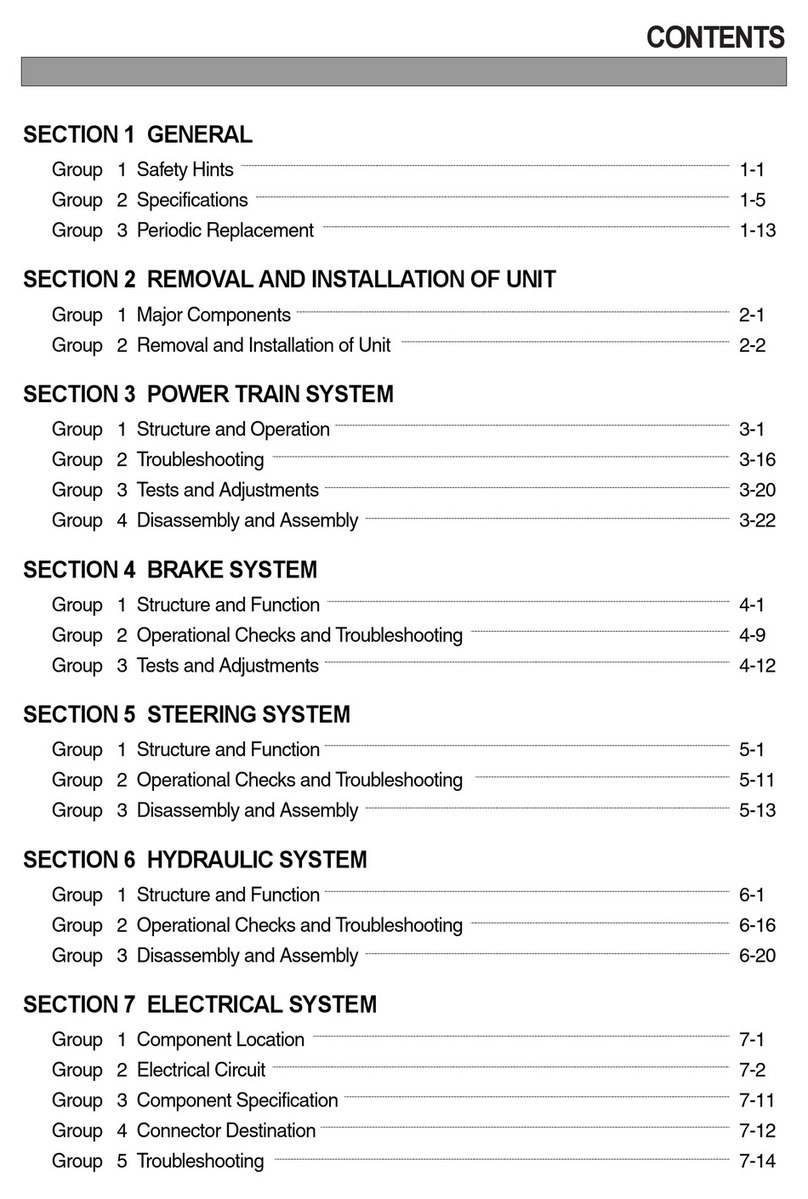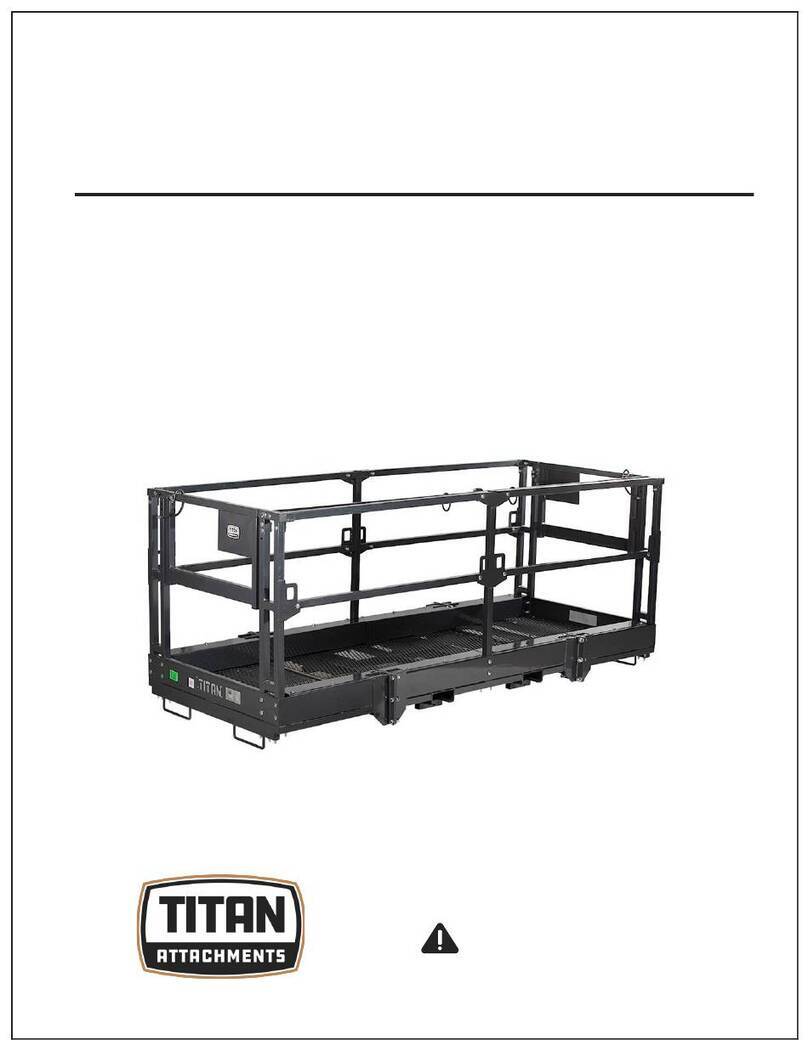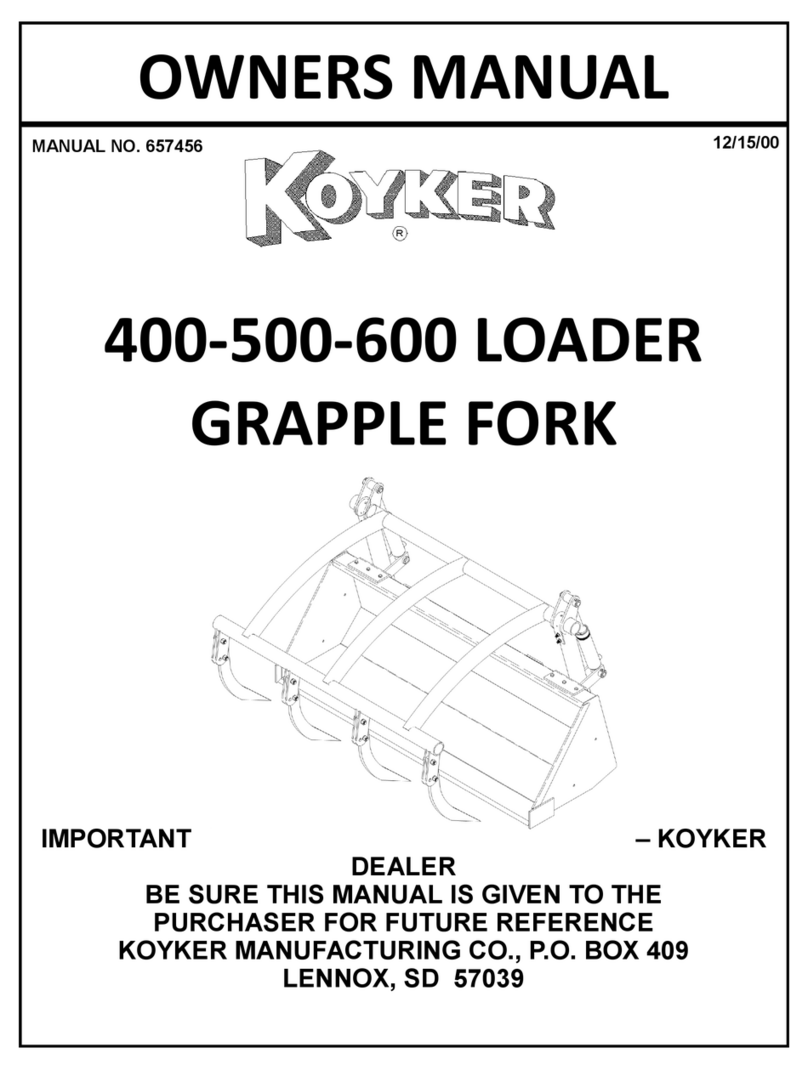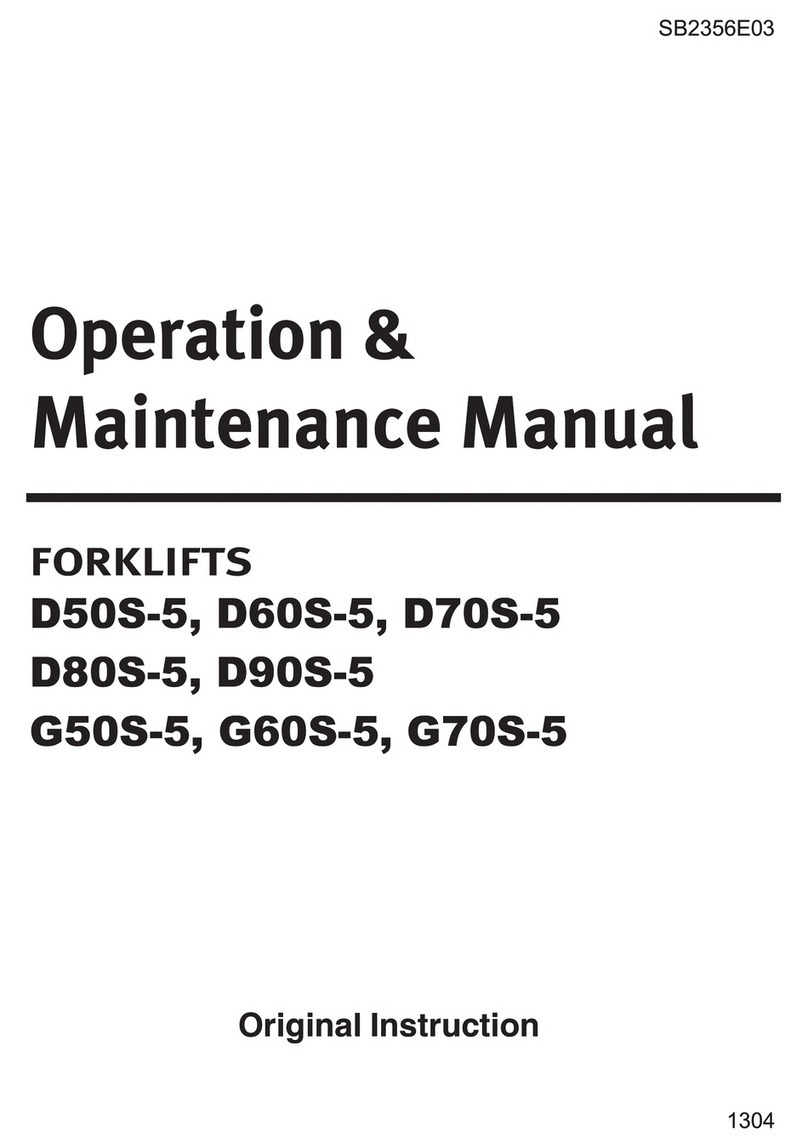HANGCHA CBD15-A2MC1 User manual

ELECTRIC PALLET TRUCK
CBD15-A2MC1
CBD15-A2MC1-F
OPERATION AND MAINTENANCE
MANUAL
Original Instruction
HANGCHA GROUP CO., LTD.
8/2017
Mini Range

FOREWORD
Thank you very much for purchasing the A series mini range electric pallet truck of Hangcha
Group .
A series mini range electric pallet truck is a newly developed product for warehouse logistic, it
owns characteristics as advanced performance, comfort operation, safety and security, low
maintenance cost, and is an ideal tool for handling goods in warehouse, supermarket and
workshop.
Before use the truck, relative persons must read and understand the manual, get to know how to
safely operate and maintain the truck.
Part one of this manual is about the brief introduction and correct operation of the mini range
electric pallet truck, which will tell you how to operate safely and maintain preventively; part two
will tell you the structure, working principle and maintenance of the electric pallet truck. To ensure
safety and exert the truck’s potential, all the personnel that in charge of operation maintenance
and management must read this manual thoroughly.
As the improvements of products of our company, there may be some differences between this
operation manual with your forklift truck.
If you have any questions please keep touches with HANGCHA GROUP CO., LTD. sales
department or let the agents know.
© 8/2017 HANGCHA GROUP CO., LTD

Contents
Part Ⅰ:Operation and Maintenance.......................................................................................... 1
1 Notice for use.......................................................................................................................... 1
1.1 General.................................................................................................................................... 1
1.2 Use as required ....................................................................................................................... 1
1.3 Approved application conditions.............................................................................................. 2
1.4 Cautions for the use of cold storage truck............................................................................... 3
1.5 Proprietor responsibilities........................................................................................................ 3
1.6 Attachment installation or modification to the truck................................................................. 4
2 Truck introduction.................................................................................................................... 5
2.1 General.................................................................................................................................... 5
2.2 Functional description.............................................................................................................. 6
2.3 Main part introduction.............................................................................................................. 8
2.4 Display and control.................................................................................................................. 9
2.4.1 Display................................................................................................................................... 11
2.5 Standard technical data......................................................................................................... 12
2.6 Product plates and warning labels location........................................................................... 13
3 Safety Instructions................................................................................................................. 15
4 Transport............................................................................................................................... 19
4.1 Lifting by crane ...................................................................................................................... 19
4.2 Securing the truck during transport....................................................................................... 20
4.3 Transport................................................................................................................................ 21
5 Battery................................................................................................................................... 22
5.1 Safe operation rules for battery use...................................................................................... 22
5.2 Maintenance of the Battery.................................................................................................... 22
5.3 Battery charging..................................................................................................................... 24
5.3.1 Power interface ..................................................................................................................... 24
5.3.2 Battery charging steps........................................................................................................... 24
5.3.3 Additional charge................................................................................................................... 25
5.4 Replacing battery................................................................................................................... 26
6 New truck breaking-in ........................................................................................................... 27
7 Operation............................................................................................................................... 28
7.1 Check before operation ......................................................................................................... 28
7.2 Start up .................................................................................................................................. 30
7.3 Travelling ............................................................................................................................... 31
7.4 Braking................................................................................................................................... 32
7.5 Steering.................................................................................................................................. 32
7.6 Stopping................................................................................................................................. 32
7.7 Loading.................................................................................................................................. 33
7.8 Unloading............................................................................................................................... 33
7.9 Park the truck securely.......................................................................................................... 35
8 Deposit the truck for long time.............................................................................................. 36
8.1 Deposit for long time.............................................................................................................. 36

8.2 Start running after deposit for a long time............................................................................. 36
9 Maintenance.......................................................................................................................... 37
9.1 Maintenance general............................................................................................................. 37
9.2 Periodic maintenance schedule............................................................................................. 38
9.3 Remove or installing the hood............................................................................................... 41
9.4 Remove or installing the drive wheel cover........................................................................... 42
9.5 Truck used oil and lubrication................................................................................................ 43
9.6 Check the fuses..................................................................................................................... 44
10 Relevant safety directive or standard (CE)........................................................................... 45
Part Ⅱ:Structure, Principle and Maintenance ....................................................................... 47
1Drive Unit............................................................................................................................. 47
1.1 Data sheet.............................................................................................................................. 47
1.2 Assemble and use notice ...................................................................................................... 48
1.3 Fault and troubleshooting...................................................................................................... 48
1.4 Drive Motor ............................................................................................................................ 49
1.5 Electromagnetic brake........................................................................................................... 53
1.5.1 Electromagnetic brake working principle.............................................................................. 54
1.5.2 Electromagnetic brake installation........................................................................................ 55
1.5.3 Maintenance.......................................................................................................................... 56
1.5.4 Adjust the Air Gap of the Brake............................................................................................. 57
1.5.5 Common fault and troubleshooting....................................................................................... 59
2 Hydraulic system................................................................................................................... 60
2.1 Hydraulic system working principle....................................................................................... 60
2.2 Hydraulic system fault diagnosis and correction................................................................... 61
3 Electric system...................................................................................................................... 62
3.1 Electrical schematic diagram................................................................................................. 62
3.2 Drive motor controller ............................................................................................................ 63
3.2.1 Maintenance.......................................................................................................................... 63
3.2.2 Diagnostics and Troubleshooting.......................................................................................... 64
Attachment:Table for bolt’s tightening torque.............................................................................. 66

1
Part Ⅰ:Operation and Maintenance
1 Notice for use
1.1 General
Truck in this manual is only for lifting and transporting loads.
It must be used, operated and maintained according to the information in this manual. Any other
uses are outside the design envelope and can lead to injury to persons or damage to equipment
and property.
1.2 Use as required
–Pick and place goods with trays.
–Transport goods with trays.
–Do not carry people.
–Do not over load.
–Do not push or pull loads.
–Do not work together on the same goods by multiple pallet trucks.

2
1.3 Approved application conditions
-Used in specified area as factory, tourist attraction and recreation place.
-Operation only on secure, level surfaces with sufficient capacity.
-Operation only on routes that are visible and approved by the proprietor.
-Use in specified rated load.
-Average environment temperature under continuous operating condition +25℃.
-The highest environment temperature in the short term (≤1h) +40℃.
-The lowest environment temperature under normal indoor conditions when operation +5℃.
-The lowest environment temperature under normal outdoor conditions when operation
-20℃.
-Altitude: ≤2000m.
-Negotiating inclines up to a maximum of 6 %.
-It is prohibited to travel crosswise or obliquely. When going uphill with loads, keep the loads
in front; when going downhill, keep people in front.
WARNING
It’s prohibited to use this equipment in the anti-explosion area.
Special equipment and authorisation are required if the truck is to be used in
extreme conditions (e.g. cold stores).
Cold-storage truck should meet the followings when working:
According to different grade of cold-storage truck, operate in cold storage based on standard
continuous working time. The recommended working times of our trucks are as follows:
-Do not work continuously over 2 hours in the cold storage above -18℃;
-Do not work continuously over 15 minutes/hour in the -18℃~-30℃cold storage.

3
1.4 Cautions for the use of cold storage truck
-Use special oil for cold storage, maintain and replace periodically.
-All cold storage trucks cannot be shut down or parked in cold storage, or it may cause
damage of hydraulic system and electric system.
-Before entering the cold storage, do necessary hydraulic and traction motion to the
cold-storage truck, and then enter the cold storage after temperature rises.
-If there is condensate water on the truck surface after the truck left the cold storage, only after
the surface is dry or the condensate water is complete dry can the truck enters the cold
storage again.
-Shorten the maintenance period of the lubricating point to avoid its premature wear.
-Battery cannot be empty for a long time after discharging, charge in time to keep high
electrolyte proportion and avoid electrolyte freezing.
-Different truck models with operations can improve each truck functions in the cold storage.
-If the truck malfunctioned in the cold storage, remove it from the cold storage immediately and
repair in buffer zone or maintenance area.
1.5 Proprietor responsibilities
For the purposes of the present operating instructions the “proprietor” is defined as any natural or
legal person who either uses the industrial truck himself, or on whose behalf it is used. In special
cases (e.g. leasing or renting) the proprietor is considered the person who, in accordance with
existing contractual agreements between the owner and user of the industrial truck, is charged
with operational duties.
The proprietor must ensure that the industrial truck is used only for the purpose for which it is
intended and that there is no danger to life and limb of the user and third parties. Furthermore,
accident prevention regulations, safety regulations and operating, servicing and repair guidelines
must be followed. The proprietor must ensure that all users have read and understood these
operating instructions.
Failure to comply with the operating instructions shall invalidate the warranty. The same applies if
improper work is carried out on the truck by the customer or third parties without the permission of
the manufacturer.

4
1.6Attachment installation or modification to the truck
Without authorization by the manufacturer, it is not allowed to modify the truck privately.
The mounting or installation of any attachments which will interfere with, or supplement, the
functions of the truck is permitted only after written approval by the manufacturer has been
obtained. If necessary, the approval of local authorities has to be obtained.
Without the prior written approval of the original manufacturer, its authorized representative or its
successor, any change to the truck that may influence its performance, such as rated capacity,
stability or security, is not allowed. Changes include brake, steering, vision or dismountable
attachment. When the manufacturer or its successor approve to changes of the vehicle, it also
needs to make corresponding modification to vehicle nameplate, decals, logo and brochures.
In the event the truck manufacturer is no longer in business and there is no successor in the
interest to the business, the user may arrange for a modification or alteration to a powered
industrial truck manufacturer and the user shall:
a) Arrange for the modification or alteration to be designed, tested and implemented by an
engineer(s) expert in industrial trucks and their safety;
b) Maintain a permanent record of the design, test(s) and implementation of the
modification or alteration;
c) Approve and make appropriate changes to the capacity plate(s),decals, tags and
instruction handbook;
d) Affix a permanent and readily visible label to the truck stating the manner in which the
truck has been modified or altered together with the date of the modification or alteration,
and the name and address of the organization that made the modification or alteration.

5
2 Truck introduction
2.1 General
A series mini range electric pallet truck described in this manual should work under low working
strength and its continuous working time should not surpass one hour.
Users can get relevant information as rated load from the product model.
Model
Meaning
CBD
Electric pallet truck
15
Rated load capacity×100kg
A
Product serial number
2
The second version
M
Mini Range
C1
Controller type
F
Cold storage type

6
2.2 Functional description
Truck body system
–Beautiful and compact outline, concise and fluent line.
–Adopted steel stamping and injection moulding process is sturdy and durable.
–The chassis adopts 3-wheel structure, and equips with side supporting system, it is safe and
reliable.
Driving system
–Drive unit adopts wheel type, with compact and simple structure.
–Permanent-magnetic drive motor owns excellent performance.
–High performance electromagnetic brake.
Braking system
–It owns three emergency braking functions as release brake, reverse brake and
electromagnetic brake to ensure travelling safety.
–It owns slope anti-slide function to ensure safety.
Operation steering system
–New ergonomics designed control handle owns acceleration, reversing, horn, braking,
lifting/lowering, emergency reverse functions, thus makes operation easier.
–Emergency reversing button on the control handle head can prevent driver from hurt when
encountering emergency in backward driving.
–Steering angle +/- 90°.
Hydraulic system
–Modularization hydraulic power unit owns low noise, low vibration, stable and reliable lifting
and lowering.
Lifting system
–Adopted single-cylinder two-connecting rod structure is simple and reliable, with good lifting
synchronism.
Electric system
–24V Electric system.
–Latest CURTIS permanent magnetic control system.

7
–Built in charger, maintenance-free colloidal battery.
–Electric quantity display meter and charging indicator indicates battery quantity and charging
process.
–Emergency disconnect switch.
–The standard equipped electronic lifting limitation and soft landing system protect working
motor and loads from damaging

8
2.3 Main part introduction
Item
Description
Item
Description
1
Control handle
10
Load wheel
2
Control lever
11
Fork
3
Lift cylinder
12
Wire fixator
4
Drive wheel cover
13
Battery charging plug(built-in plug)
5
Caster wheel
14
Instrument
6
Drive wheel
15
Hood
7
Fault indicator
16
Emergency stop switch
8
Side door (built-in battery)
17
Key switch
9
Charging light indicator (with built-in charger)
1
2
3
4
5
6
5
7
8
9
10
11
17
16
15
14
13
12

9
2.4 Display and control
2
7
9
17
16
14
13
19 20 21 20
19
22
23
22
18

10
Item
Designation
Function
2
Control lever
Control the steering and brake of the truck.
7
Fault indicator
Normally on normal condition. Failure regularity, see
the failure code.
9
Charging light indicator
Green light: Fully charged.
Yellow lingth: Fault
Red light: Charging
13
Battery charging plug(built-in
plug)
Insert the plug into the power outlet for battery
charging.
14
Instrument
Shows the accumulated operating hours of the truck,
the residual capacity of the battery and the fault
code(refer to “Instrument” part)
16
Emergency stop switch
Cut the connection with the battery, close all electric
function and brake.
17
Key switch
Switches the control current ON and OFF.
The truck cannot be operated by unauthorized
persons when the key has been removed from the
switch.
18
Upright traveling button
Press the button, the control lever in vertical state
truck can run.
19
“Lower”button
Lower lifting device.
20
“Lift”button
Raise lifting device. When the battery is consumed
about 80%, lifting function will be locked.
21
Horn button
Give out sound warning signal.
22
Travel switch
Control travelling direction and speed.
23
Collision safety switch
Truck moves away from operator.
Protect the operator from extrusion damage under
emergent circumstances.

11
2.4.1 Display
Instrument [14]
It displays battery power.
10 LED display bars display battery discharging status. One LED means 10% battery power. As
the battery power reduces, 10 LED will light up one by one from right to left.
When the remaining capacity is less than 40%, need to stop charging.
Fully charged Need charge Low charging status
One red LED flashing means the truck start to use reserve power (30~20% of battery power).
When it is lower than 20% of battery power(low charging status), two red LED flashes and power
is locked. Only after the battery power recovered to 20% or above can re-use the lifting function.
Charging light indicator [9]
It displays charger running state.
–Red light flashes-it is charging.
–Yellow light is on- charging fault.
–Green light is on- charging finishes.
Notes: Overnight charging recommend after use !
01
CURTIS
01
CURTIS
01
CURTIS

12
2.5 Standard technical data
The following technical data are all standard data. Our company reserves the right of alteration
and extension.
Characteristics
Model
CBD15-A2MC1
CBD15-A2MC1-F
Operator type
Pedestrian
Load capacity
Q (kg)
1500
Load center
c(mm)
600
Wheelbase
y(mm)
1285
Weight
Service weight with battery
kg
220
Wheels﹠Tyres
Tyre type
PU
Tyre size/Quantity,operator side
mm
Φ210×70/1
Tyre size/Quantity,load side
mm
Φ80×64/4
Tyre size/Quantity,Additonal wheels
mm
Φ70×40/2
Tread, operator side
b10(mm)
404
Tread, load side
b11(mm)
400
Dimensions
Lift height
h3(mm)
120
Fork height, lowered
h13(mm)
80
Overall length
L1(mm)
1669
Overall width
b1(mm)
568
Fork size
s/e/L(mm)
50×160×1150
Outside fork width
b5(mm)
560/680
Ground clearance, center of wheelbase, min
m2(mm)
30
Min, right angle stacking aisle width1000×1200 across forks
Ast(mm)
18501)
Min, ringht angle stacking aisle width 800×1200 across forks
Ast(mm)
19002)
Outer turning radius, min
Wa(mm)
14003)
Performance
Travel speed, laden/unladen
km/h
4.5/4.9
Lift speed, laden/unladen
mm/s
50/60
Lowering speed, laden/unladen
mm/s
40/45
Max Gradeability, laden/unladen
%
6 / 15
Motor﹠Battery
Drive motor power
kW
0.65
Lift motor power
kW
0.8
Battery voltage, rated capacity
V/Ah
2×12/70
Battery weight
kg
50
Controller mode
Curtis DC

13
2.6 Product plates and warning labels location
Plates and labels, such as nameplate, load curve plate, warning labels must be legible, if
identification is unclear, and must be replaced.
The figure below shows the approximate location of the various identity resides. Before operating
the truck, please understand the meaning of the various identities.

14
Item
Description
24
Nameplate: The rated capacity on the nameplate is the max. load capacity by the label
listed equipment. Any change to the forklift or other equipment may change rated
capacity.
25
Fault indicator
26
Hoist label: Strap points for crane lifting.
27
Manufacturer’s logo
28
Charging light indicator. Overnight charging recommend after use !
29
Key switch:“OFF” position is off,“ON” position is on.
30
Emergency stop label: press this button when in emergency, thus the truck power is
off.
31
Series tonnage label:A series, rated capacity is 1.5t.
32
Walking upright.

15
3Safety Instructions
1) Only trained and authorized operator
shall be permitted to operate the truck.
2) Operator must wear helmet, working
shoes and uniform
3) Never carry people.
4) It is not allowed to reconfigure the truck
without manufacturer’s permission.
5) Do not work in flammable and
combustible environment.
6) Check the oil, fluid leakage, deformation,
flexibility in certain time. If neglected,
service life of forklift will be shorted and
in serious condition there will be
accident.
–Make sure change the “safety parts”
during the schedule maintenance.
–Wipe off the oil, grease or water on the
soleplate, foot pedal and control lever.
–No smoking or any spark, smoke near
the battery when checking.
–Be careful of scald when checking motor
and controller.
7) The controller equips with energy
accumulator, do not touch between B+
and B- to avoid electric injury. If you
need check or clean the controller,
connect load(like contactor coil or horn
or bulb or resistance) between
controller B+ and B- to discharge the
controller capacity.
8) Whenever you find the forklift abnormal,
stop the truck, put on the DANGEROUS
or FAULT sign to the truck, remove the
key, and report to the managing person.
Only after eliminating the fault can you
use the truck.

16
–If there occurs to fault, battery electrolyte,
hydraulic oil leakage when lifting loads,
going up and down the slope, please
organize staff to repair.
9) Internal battery may generate explosive
gas, it’s prohibited any flame close the
battery. Never allow the tools close two
poles of the battery to avoid spark or
short circuit.
10) The work ground of forklift shall be solid
and smooth concrete surface or similar
ones. Pre-check the ground condition of
working site. Tidy the working site, clean
obstacle, sweep macadam, muddy sand
and wipe off greasy dirt.
11) Do not overload.
12) Before start, press the horn and make
sure no people around.
13) Goods are not allowed to deviate the
fork center, when goods is deviating the
fork center, turn or pass uneven road,
you are easily to fall. Meanwhile,
possibility of turnover will increase.
14) Avoid sudden drive, stop or turn.
15) Do not drive the truck when the forks in
high position.
16) When handling bulky loads, which
restrict your vision, please operate the
machine in reverse or have a guide.
17) Cause the wheels of pallet truck is small,
it is not allowed to run on the street, and
only for driving in specified stacking
place.
18) It’s forbidden to put the head, hand, foot
or body under the forks. Never stand on
the fork.
Failure
This manual suits for next models
1
Table of contents
Other HANGCHA Forklift manuals
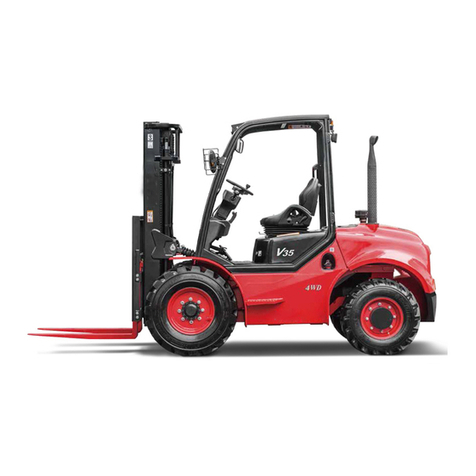
HANGCHA
HANGCHA CPCD30/35-XW43E-RT Quick start guide
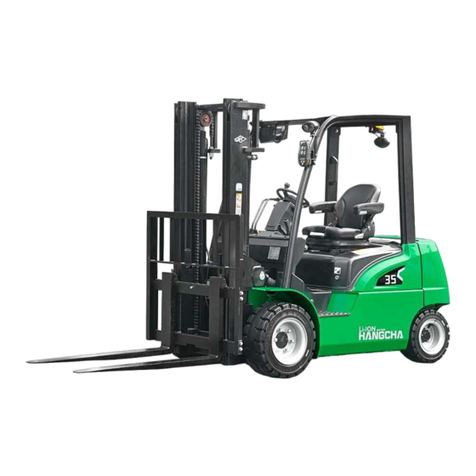
HANGCHA
HANGCHA XC Series User manual

HANGCHA
HANGCHA XF Series User manual
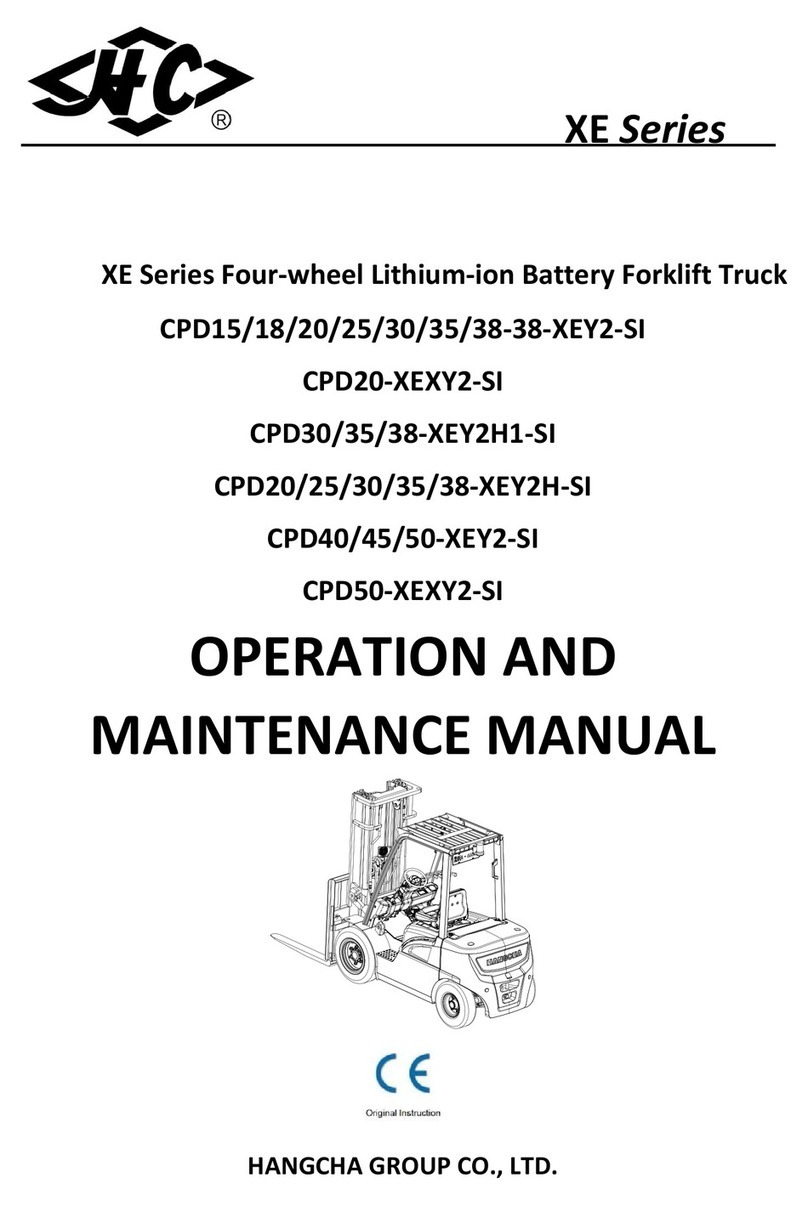
HANGCHA
HANGCHA XE Series User manual
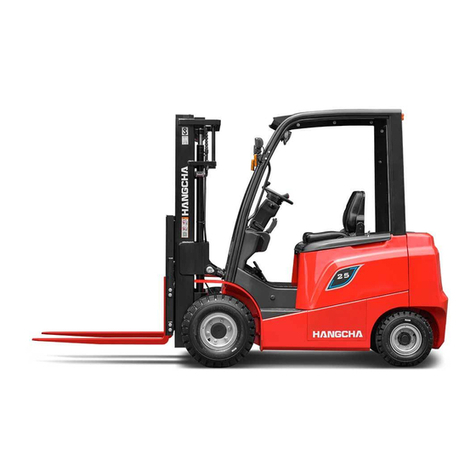
HANGCHA
HANGCHA CPD10-A User manual
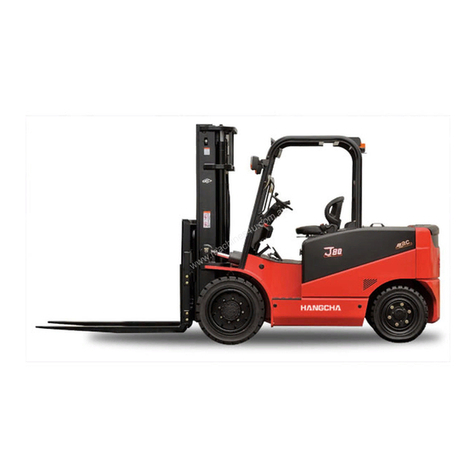
HANGCHA
HANGCHA J Series User manual
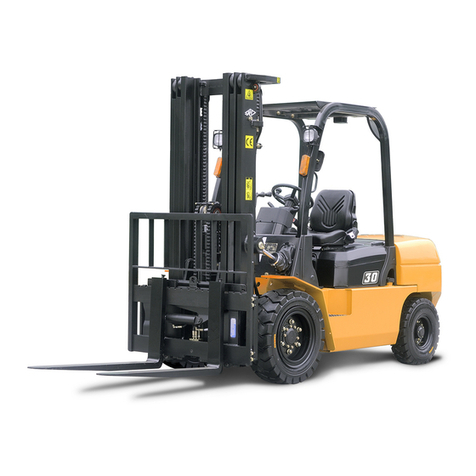
HANGCHA
HANGCHA R Series User manual

HANGCHA
HANGCHA CBD20-AMC1 Installation guide

HANGCHA
HANGCHA XF Series Quick start guide


